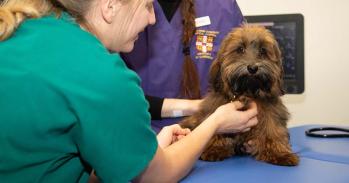
An industrial-grade aerospace gas turbine combustion simulator – the first of its kind in the UK and one of only a dozen worldwide – is ready for ‘lift off’.
An industrial-grade aerospace gas turbine combustion simulator – the first of its kind in the UK and one of only a dozen worldwide – is ready for ‘lift off’.
This optically accessible rig will now allow us to see what effect small geometry changes have on the flame structure, so that we can move towards designing cleaner and more efficient engines from scratch.
Professor Hochgreb
Professor Simone Hochgreb and colleagues in the Department of Engineering have built the rig to support the Environmentally Friendly Engine programme, which brings together a UK-wide, cross-sectoral consortium of academic and industrial partners under the leadership of Rolls-Royce. Launched in 2006 under the UK’s National Aerospace Technology Strategy, the £95 million programme receives funding from the UK Government’s Technology Programme, Regional Development Agencies and Rolls-Royce and its collaborating industries.
The partnership’s aim is to take UK aerospace capabilities to the next level of efficiency. ‘With no current practical alternative to oil-based fuels for air travel, the aerospace industry is asking how we can burn fuel more efficiently and cleanly,’ explained Professor Hochgreb. The goals are impressive: the programme aims to deliver a 10% reduction in carbon dioxide emissions and a 60% reduction in nitrous oxide emissions as a significant step towards the targets for the aerospace industry set for 2020.
Detailed understanding of combustion under realistic conditions is a very challenging area of research in gas turbine engineering, and one that holds great promise in the quest for more environmentally friendly engines. ‘In the past, it’s been very difficult to set down design rules for fuel injectors because it’s the details that matter,’ Professor Hochgreb explained. ‘This optically accessible rig will now allow us to see what effect small geometry changes have on the flame structure, so that we can move towards designing cleaner and more efficient engines from scratch.’
Although a new area of research, Professor Hochgreb’s work falls under the umbrella of the UGTP. With research projects in the Departments of Engineering, Chemical Engineering and Applied Maths, the UGTP’s purpose is to create an holistic understanding of the linkages between aerodynamics, noise and vibration, combustion, heat transfer and advanced cycles in turbomachinery.
Director of the UGTP, Professor Dame Ann Dowling, explained: ‘The UGTP model – with its two-way information flow and regular contact between research staff, students and Rolls-Royce engineers – ensures that we address the right problems with the right people, and is both exciting and motivating for staff and students.’
For more information, please contact Professor Simone Hochgreb (sh372@cam.ac.uk).
Rolls-Royce
Research is the foundation stone for the high-technology products that Rolls-Royce designs and develops for its extremely competitive aerospace, marine and energy businesses. Each market sector sets substantial economic, operational and environmental challenges that call for accurate, long-range, research-based, technology planning.
Rolls-Royce, in collaboration with its partners, spends around £800 million annually on research and development. Its research strategy embraces three ‘Visions’ addressing the 5-, 10- and 20-year timeframes, which broadly are devoted to technology validation, applied research and fundamental research, respectively.
A key element of the longer-range Vision 10 and Vision 20 programmes is the network of Rolls-Royce-supported University Technology Centres (UTCs). Over the past 18 years, some 29 UTCs (20 in the UK, the remainder in Europe, USA and Asia) have been carefully selected as the very best in their fields to address critical technical areas as diverse as materials, noise, combustion, aerodynamics and manufacturing technology. In cases where UTCs are highly complementary in their research focus, they have been linked together to form University Technology Partnerships (UTPs).
The University of Cambridge, with which Rolls-Royce has deep and long-established research links, has played a key role in the UTC network through three research programmes:
- The Cambridge University Gas Turbine Partnership (UGTP) includes the world-renowned Whittle Laboratory and over 80 projects, such as the Environmentally Friendly Engine (see panel), whose collective purpose is to provide an integrated approach to gas turbine fluid mechanics and thermodynamics.
- The Materials UTC in the Department of Materials Science and Metallurgy conducts research into high-temperature superalloys used in the hottest components of gas turbine engines (see panel).
- The Engineering Design Centre (EDC) in the Department of Engineering has provided the Engineering Knowledge Management UTC of a wider UTP for Design. The project addressed the need to capture, store and retrieve engineering knowledge to improve design processes.
The UTCs and UTPs are highly regarded as models for effective industrial– academic collaborative research. Their long-term nature and real-world challenges bring mutual benefits: Rolls-Royce finds solutions to complex technical challenges; the universities gain an ongoing five-year stability of funding and a greater depth and quality to their academic research; and the science base is broadened by developing a strong pool of highly skilled engineers and scientists.
This work is licensed under a Creative Commons Licence. If you use this content on your site please link back to this page.





